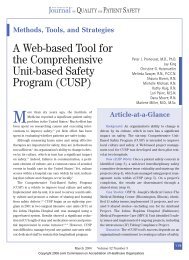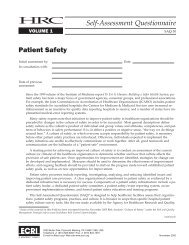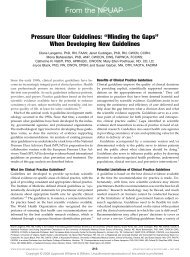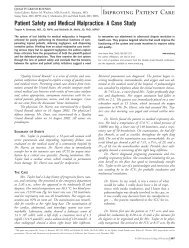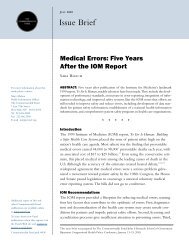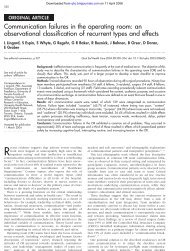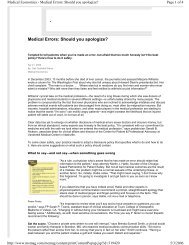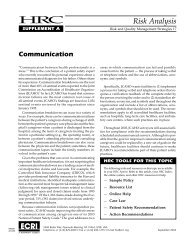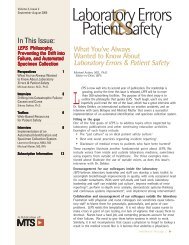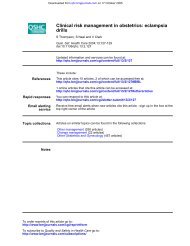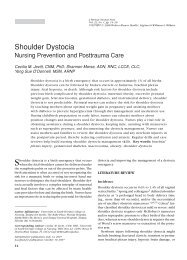Chain of Command - MCIC Vermont Patient Safety Documents
Chain of Command - MCIC Vermont Patient Safety Documents
Chain of Command - MCIC Vermont Patient Safety Documents
You also want an ePaper? Increase the reach of your titles
YUMPU automatically turns print PDFs into web optimized ePapers that Google loves.
4 Healthcare Risk Control<br />
• The process for handling clinical disagreements allows<br />
me to bypass the prescriber or my supervisor if<br />
necessary.<br />
If the underlying milieu is found to be unsupportive<br />
<strong>of</strong> teamwork and interpr<strong>of</strong>essional communication,<br />
leadership should make efforts to improve communications<br />
and enhance the culture <strong>of</strong> safety. Leadership backing<br />
is crucial to such efforts and may involve a<br />
unit-specific approach. 15 Culture-<strong>of</strong>-safety survey results<br />
that indicate a need to improve communication and<br />
teamwork can garner leadership support and, thus, allocation<br />
<strong>of</strong> the resources necessary to improve the culture<br />
<strong>of</strong> safety.<br />
Crew resource management, an approach to team<br />
building and assertive communication in healthcare that<br />
was adapted from a military model, is being used to enhance<br />
communication and improve the culture <strong>of</strong> safety<br />
in hospitals. (See “Crew Resource Management Encourages<br />
Assertion in Healthcare.”)<br />
The risk manager can also gain leadership support for<br />
clear chain-<strong>of</strong>-command policies by providing information<br />
on liability claims that exemplify how the lack <strong>of</strong> (or<br />
failure to invoke) chain-<strong>of</strong>-command policies affected patient<br />
outcomes and/or ability to defend the claims. The<br />
risk manager would also play a key role in conducting<br />
safety culture surveys and in providing education about<br />
Crew Resource Management Encourages<br />
Assertion in Healthcare<br />
One approach to breaking down hierarchies, fostering<br />
assertive communications, and building teams currently<br />
being tested in healthcare came from the U.S.<br />
Department <strong>of</strong> Defense. Instituted by the U.S. military<br />
after numerous aircraft crashes, crew resource management<br />
(CRM) makes everyone responsible for flight<br />
safety and focuses on communication, stress management,<br />
and other human-factors concepts to prevent<br />
aviation mishaps. 1 With CRM, if a problem is detected,<br />
all team members are held accountable for fixing the<br />
problem or, if the problem is not within their realm, for<br />
notifying someone who can fix it.<br />
CRM has been adapted for use in military medicine<br />
and renamed “Medical Team Management.” 2 Other<br />
adaptations <strong>of</strong> the CRM concept include the Operating<br />
Room Human Factors Project 3 and emergency department<br />
MedTeams. 4 One important and similar aspect<br />
<strong>of</strong> these programs is that all team members are urged<br />
to speak up when there is a problem, and the leader(s)<br />
are expected to listen. Everyone is taught respectful assertion.<br />
Other features <strong>of</strong> these programs include education<br />
in team building and communication through<br />
role playing and implementing “briefings.” A briefing<br />
is the direct communication between physicians,<br />
nurses, or other care givers on patient status that includes<br />
transfer <strong>of</strong> important patient information at<br />
critical times such as prior to before the start <strong>of</strong> a procedure,<br />
at the change <strong>of</strong> shift, or during morning<br />
rounds.<br />
The crux <strong>of</strong> good communication skills that forms<br />
the foundation <strong>of</strong> CRM is for all team members to use<br />
and understand well-defined language. 5 Using a predetermined<br />
way <strong>of</strong> communicating that there is a<br />
problem reduces misunderstandings and increases<br />
appropriate interventions to correct the problem. Everyone<br />
on the team recognizes that with this type <strong>of</strong><br />
communication, they must pay attention, listen, and<br />
act. CRM can prevent communication breakdowns<br />
through team building, reducing the need to invoke<br />
the formal chain <strong>of</strong> command to obtain necessary patient<br />
care. Clear communication and improved patient<br />
safety can be the most direct benefits <strong>of</strong> CRM. 6<br />
Notes<br />
1. Stone FP. Medical team management: using teamwork to<br />
prevent medical errors [online]. Legal Medicine 2001 [cited<br />
2004 Jun 9]. Available from Internet: http://www.afip.<br />
org/Departments/legalmed/legmed2001/medical.htm.<br />
2. Ibid.<br />
3. University <strong>of</strong> Texas Center <strong>of</strong> Excellence in <strong>Patient</strong> <strong>Safety</strong><br />
Research. Research into medical human factors and human<br />
error in medicine [online]. [cited 2004 Jun 11]. Available<br />
from Internet: http://homepage.psy.utexas.edu/<br />
homepage/group/HelmreichLAB/Medicine/medicine.<br />
html.<br />
4. Dynamics Research Corporation. MedTeams products<br />
and services [online]. [cited 2004 Jun 11]. Available from<br />
Internet: http://www.drc.com/TrainingAnalysis/<br />
products.htm.<br />
5. Crew resource management promises adverse events.<br />
Healthc Risk Manage 2003 Sep;25(9):103-5.<br />
6. Ibid.<br />
©2004 ECRI. May be reproduced by member institution only for distribution within its own facility.



